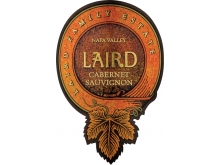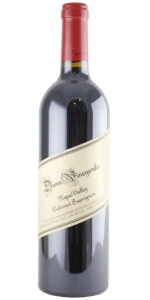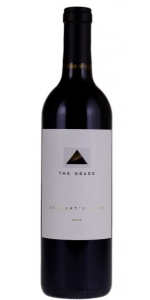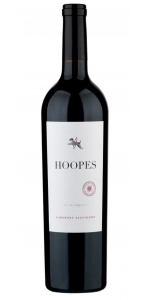Laird Cabernet Sauvignon Napa Valley 2019
| Country: | United States |
| Regions: | California California (Napa) |
| Winery: | Laird |
| Grape Type: | Cabernet Sauvignon |
| Organic: | Yes |
| Vintage: | 2019 |
| Bottle Size: | 750 ml |
Laird Cabernet Sauvignon Flat Rock Ranch is made from 100 percent Cabernet Sauvignon.
Laird's Flat Rock Ranch vineyard is located near the north corner of where Yountville Cross Road meets Silverado Trail, on State Lane. This prized, complex fruit from the Yountville Appellation is a result of unique geological and meteorological conditions: volcanic soils similar to the adjacent Stags Leap District, but also display ancient coastal deposits, and sedimentary and alluvial soils that provide beneficial stress for our vines. Marine air currents from San Pablo Bay to the south are caught when they reach the "Yountville Mounts," providing a natural cooling effect that balances warm, sunny days that ripen the rich tannins of our hallmark Cabernet Sauvignon to elegant distinction.
Bold violet-red color introduces a captivating bouquet of blueberries, tea leaf, and vanilla. This full-bodied wine has flavors of cassis, hazelnut and briary undertones with fresh acidity and chewy tannins on the palate
Review:
"The 2018 Cabernet Sauvignon Flat Rock is laced with crème de cassis, menthol, lavender, spice and blueberry jam. Inky and plush, the 2018 also has quite a bit of energy backing it all up. The 2018 is a gorgeous wine from Laird.- Antonio GALLONI"
- Vinous (The 2019 Napa Valley Cabernets: A Deep Dive, January 2022), 93+ pts
Cardinale Napa Valley Cabernet Sauvignon is made from 91% Cabernet Sauvignon, 9% Merlot.
Super structured and with minerality to spare, this Cabernet Sauvignon offers a real presence on the palate from start to finish. Generous notes of dark chocolate balance beautifully with a blue and black fruit flavor explosion, finishing with a subtle whisper of rose petal.
Reviews:
- James Suckling 98 Points
-Jeb Dunnuck 98+ Points
Dunn Vineyards Napa Valley Cabernet Sauvignon is made from 100 percent Cabernet.
This Napa Valley wine is a blend of their Howell Mountain fruit and a small quantity of valley floor fruit that they purchase. This valley floor fruit contributes to the wine’s earlier approachability and softer tannic structure.
Review:
I loved the 2019 Cabernet Sauvignon Napa Valley, which I think is a step up over the 2018, although both 2019s show a much more elegant profile. Ripe currants, plums, roasted herbs, violets, and incense notes all shine in this medium to full-bodied, ripe, supple, layered beauty, which has fine tannins and a gorgeous finish. Enjoy bottles any time over the coming 15 years.
-Jeb Dunnuck 94 Points
The Grade Cabernet Sauvignon Serpent's Back Napa Valley is made from 100 percent Cabernet Sauvignon.
Review:
The 2019 Cabernet Sauvignon Serpent's Back shows a more aromatic, high-toned side of this site. Bright red/purplish berry fruit, pomegranate, cinnamon and sweet floral accents are all laced together. The Serpent's Back is the most refined of these three Cabernets, but it has plenty of Calistoga punch.
-- Antonio Galloni 95 Points
The Grade Cabernet Sauvignon Serpent's Back Napa Valley is made from 100 percent Cabernet Sauvignon.
Review:
The 2019 Cabernet Sauvignon Serpent's Back shows a more aromatic, high-toned side of this site. Bright red/purplish berry fruit, pomegranate, cinnamon and sweet floral accents are all laced together. The Serpent's Back is the most refined of these three Cabernets, but it has plenty of Calistoga punch.
-- Antonio Galloni 95 Points
Hoopes Cabernet Sauvignon Napa Valley is made from 100 percent Cabernet Sauvignon.
“Made with the same care and thoughtfulness of our single vineyard series, the Hoopes Napa Valley Cabernet Sauvignon is a blend of fruit from a rich variety of sites. The synthesis of these vineyards, which represent the complex tapestry of Napa terroir, results in sublime balance, intense aromas and luscious textures that bring the diverse valley into harmony in a glass. Born out of curiosity, this Cabernet Sauvignon has matured into a stunning wine, which over delivers in intensity and richness. We are proud of this beautiful example of what the Napa Valley can do.”
This wine has a very pretty fruit-forward nose filled with plummy sweet tarts, cherry compote, cocoa nibs, hard candy, cedar box, and allspice. The entry is fresh and clean with a core of delicious generous fruit. It has a lovely elegant texture, weighty middle and resolves into a mocha filled finish.
Laird Cabernet Sauvignon Napa Valley is made from 100 percent Napa Cabernet.
This 100% Cabernet Sauvignon is sourced from three vineyards: Mast Ranch, for its earthy and robust structure, Flat Rock Ranch, for its fruit-forward characteristic and silky structure, and Linda Vista Ranch, for its juicy and vibrant approach-ability.
Tasting Notes: Opaque ruby color with a tinge of purple introduces developing aromas of blackberry jam, cranberry, and acacia flower. This medium-bodied red wine expresses flavors of ripe black plum, walnut, and cassis on the front of the palate, and is complemented by chewy tannins and juicy cherry on the finish.
Vineyard: 42% Mast Ranch + 35% Flat Rock Ranch + 23% Linda Vista Ranch
Appellation: Napa Valley
Varietal: 100% Cabernet Sauvignon
Review:
"Fruity nose of baked blueberries, ripe blackberries, cherry pie, sweet spices, licorice, tobacco leaves and chocolate. Full-bodied with firm, polished tannins. Beautifully rich, succulent core of blue and black fruit. Better from 2023."
- James Suckling (December 2021), 93 pts
After nearly 50 years in the wine business, we understand the ins and outs of the industry, from the trends to the challenges. We believe that our success is due to our vineyard expertise as well as our shared goal to produce great estate wines.
With a concentration on Napa and Carneros vineyards, we have sought to produce wines that are “a window to a place.” Each one of our vineyards is different in expression, with its own subtle, yet distinctive character and voice. Each year renews in us an intense drive to understand, react to, and work with each vineyard to allow it to reach its full potential. This process, lead by our winemaking and vineyard management team, is crucial for the execution of successful wines.
With a concentration in Napa and Carneros vineyards, we have sought to produce wines that are “a window to a place.” Each one of our vineyards is different in expression: each has a subtle, yet distinctive vineyard voice. With every year there is an intense drive to understand, react to and work with each vineyard to reach its full potential. This process, lead by winemaker and vineyard manager, is crucial for the execution of successful wines.
While growing up to be a big city mechanical engineer in New York City, Ken held on to his family tradition of becoming a farmer. In 1970, Ken and his wife, Gail, purchased their first Napa Valley parcel. This neglected piece of land, adjacent to Tubbs Lane in Calistoga, held 70 acres of worn-down prune trees. With Prohibition forty years gone and Napa Valley positioned to re-emerge as viticulturally significant, Ken and Gail decided to develop the orchard into a grape vineyard. While knowing just short of nothing about viticulture, they were also $150,000 short to properly develop the orchard into a respectable vineyard. Picking up a tattered phone book, Ken went to the yellow pages and found eight listed wineries…Robert Mondavi being the only one he recognized.
With a phone call, Robert Mondavi himself agreed to walk the property. After they discussed soils, vines, yields, irrigation, and proper pruning, Robert agreed to finance a deal with the Lairds if they would plant 50% Gamay. The deal was struck with a resulting vineyard of 50% Gamay and 50% Cabernet Sauvignon. Mr. Mondavi guaranteeing the Laird’s Cabernet “to be the highest harvest price paid in the Valley.” The support and encouragement of Robert Mondavi would allow Ken to return to his passion: his family farming heritage.
By the late 1990’s the Laird vineyard holdings had exceeded 2,000 acres and the idea of making their own premium line of wines began to take shape. Architect, Jon Lail, showed Ken and Gail the plans for the iconic pyramid-shaped, multi-level winery. Construction began on what would become the Red Hen Ranch vineyard property north of Napa. Ken and Gail’s son, Justin, worked side-by-side with Ken in the vineyards and became the Vineyard Manger, while their daughter, Rebecca, became the General Manager of the winery. Rebecca’s daughter, Jillian, was born in 2005, the same year the winery’s first red blend was produced, appropriately named Jillian’s Blend (and it happens to be Laird Family Estate’s most popular wine). Justin’s daughter, Megan, works in finance in New York City. His son, David, is continuing the family’s farming legacy by working with his dad in the vineyards.
The vineyard holdings possess a cross section of geomorphic and microclimate idiosyncrasies that are poised to produce particular grape varieties that thrive in their desired terroir.
From the thick fog and marine winds in Carneros to the volcanic soils mixed with ancient coastal deposits in the lower bench of the Mayacamas Mountains, they farm their vineyards to produce fruit that best complements the hallmarks of the land.
- back
Long Shadows Sequel Syrah is made from 95% Syrah, 5% Cabernet Sauvignon.
An intensely colored wine with spicy aromas of cassis, smoked meats and a hint of olive tapenade woven throughout layers of black currant, blueberry and a trace of licorice. Wonderfully balanced, with a broad mouth-feel and soft tannins that hold together seamlessly.
Winemaking: Syrah’s delicate skin requires gentle handling during fermentation to extract richness without imparting bitter tannins, so winemaker John Duval uses a variety of techniques to produce a wide spectrum of flavors. A portion of the grapes were fermented using an Australian method known as “rack and return” that requires draining the tank twice daily and gently putting the juice back over the top of the skins. Whole-cluster fermentation was also used to enhance richness and dimension on the palate. Lastly, some of the lots underwent submerged cap fermentation to add structure and enhance the mouthfeel of the finished wine. Aged 18 months in 100% French oak barrels, 65% new.
Review:
Loads of black fruits, smoked game, liquid violets, and cracked pepper notes emerge from the 2018 Syrah Sequel, which has gorgeous Syrah wildness and gaminess, full-bodied richness, a pure, elegant, seamless texture, ultra-fine tannins, and a great finish. Count me impressed. You could safely put this up with the best Syrah coming out of Washington and California.
-Jeb Dunnuck 97 Points
Winemaker’s Notes
Our organically farmed high-density Estate parcel sits at the top of the ridge amongst the diverse coastal forest. Although the soil is sandy, there’s a vein of clay in the subsoil that holds winter rain and allows us to dry-farm the vines. The tight spacing keeps the clusters and soil shaded during the summer heat, which allows the fruit to retain all the nuance of the site. The wine produced here has a character - a signature - all to itself and cannot be replicated elsewhere; it's the antithesis of fruity, forward, easy-to-understand Californian Chardonnay. The grapes are small with thick skins, producing a high level of fruit extract, which translates to deep texture and structure in the wine itself. Concentration allied to freshness is the essence of this wine, and it ages beautifully in bottle for ten to twelve years.
The wine’s aromas and flavors are incredibly complex and diverse, akin to citrus oil, preserved lemon, sage, fennel and caraway. The wine is deep, powerful, and layered with oyster shell freshness cutting through the natural density. Lemongrass, spearmint, and grapefruit power the finish, which pulsates with intensity. You could decant this for an hour before serving to hasten its development. Drink between 2025 and 2030. Serve no cooler than 55º F.
Review:
From a site surrounded by dense forest on two sides, the 2022 Chardonnay DuMOL Estate Vineyard is a bright straw hue and has a more vibrant aromatic nose of fresh mint, bright lime, flint, crushed stones, and white peach. Medium to full-bodied, it boasts a remarkably firm structure with a bit of tannin, a chalky texture, and a savory slanting profile, and it’s long and persistent on the finish. It has an assertive but crystalline feel and a crunchy brightness. It demands a bit of time. Drink 2025-2035.
-Jeb Dunnuck 96 Points











